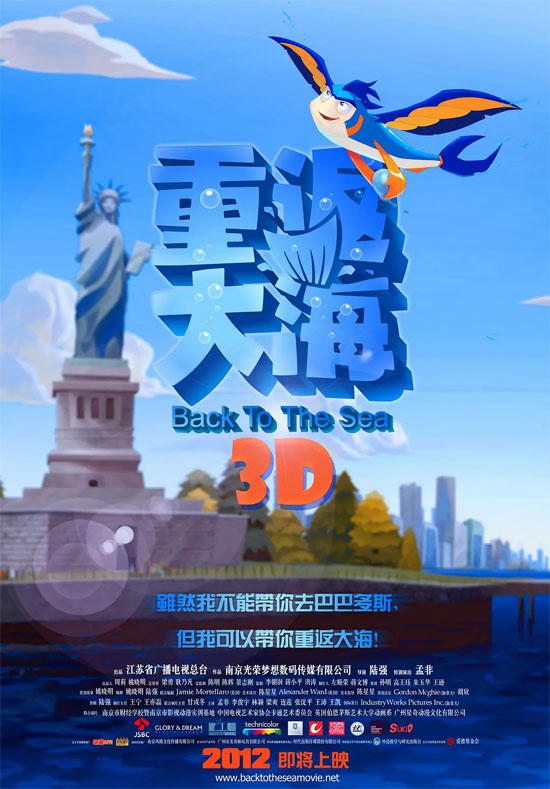Film Name: 重返大海 / Back to the Sea

This film will likely be compared by many viewers to the Pixar classic Finding Nemo. Why not?
Both feature fish protagonists. Both involve a young fish accidentally captured by humans and placed in a home aquarium. Both harbor an intense desire to return to the ocean at all costs. Both encounter a diverse group of new friends within the aquarium. Both even have an authoritative leader who holds absolute sway within the tank…
The difference lies in the narrative structure. “Finding Nemo” follows a dual-track approach with a singular core: the profound bond between father and son. “Back to the Sea,” however, must simultaneously depict the relationship between the young boy and his father, portray the friendship between the boy and the protagonist—a flying fish named Calvin—and also carve out space to establish Calvin as a brave hero who overcomes adversity and ultimately triumphs. What a daunting task!
Undoubtedly, the most profound impression the film left on me was the stark contrast between the boy’s sorrowful expression whenever his father urged him to learn cooking skills and the pure joy that lit up his face when he retreated to his private space, leafed through his secret notebook, and immersed himself in his own personal wilderness. It raises the question: How are human values formed? Through parental dogma or through independent choice? In the film, the chef father’s countless suggestions, interrogations, and reprimands—even when well-intentioned—pale in comparison to the influence of a single National Geographic magazine on the child. If the father’s educational approach, shaped by his identity as a Chinese man in New York’s Chinatown, represents China, then National Geographic, as an American publication, seems to embody the West. Ultimately, the film subtly suggests that in shaping a child’s education and values, Chinese-style thinking yields to Western-style thinking.
As the film meticulously recounts the boy’s story with Calvin, I couldn’t help but wonder: Did Calvin’s father, the Flying Fish King, feel no concern whatsoever after losing his son and the purple pearl symbolizing his clan’s highest status? Did he take no action at all? The implication is that since the film explores father-son relationships and the anxieties of childhood, the chef father and son and the flying fish father and son actually form two pairs that can be compared and contrasted. When the film resolves the issue of the chef father imposing his own fervent aspirations onto his son, causing the boy immense pressure and confusion, imagine how perfectly balanced the entire story would be if, in the fish world, the Flying Fish King could also resolve this purely didactic relationship with his son!
Having explored the father-son bond, let’s examine Calvin’s hero arc. He navigates multiple crises—doubting himself, distrusting his friends—before devising a solution at the eleventh hour. Successfully leading the aquarium’s inhabitants to overcome the ultimate challenge, he truly embodies the qualities of a hero, with a richly developed storyline. But I can’t resist nitpicking a bit: for Calvin, returning to the ocean is merely one challenge in his hero’s journey—not the ultimate one. The ultimate challenge should be the Wishing Rock or the waters of Barbados, both repeatedly mentioned throughout the film. If Calvin’s “graduation” ceremony had taken place at the Wishing Rock, or if he had truly reached the Barbados he dreamed of, then his hero status would have been truly established. Otherwise, if the protagonist ultimately fails to reach these places, what was the point of repeatedly mentioning the Wishing Rock and Barbados in the film?
Finally, let’s revisit the friendship arc between Calvin and the young boy. Whether it’s the development of their bond, the rift that forms, the high-stakes chase through the pipes with the thief, or the last-minute rescue, this storyline receives the most screen time. Yet it fails to deliver the profound emotional resonance seen in the boy’s reconciliation with his father. Two reasons explain this: First, the boy’s design is downright unappealing—neither handsome nor cute—making it difficult for viewers to emotionally connect with him. Second, their relationship remains a plot device rather than a genuine bond. The depth of their affection feels unconvincing, overshadowed by the ever-present environmentalist agenda waving like a banner. This makes their friendship seem far more contrived than Calvin’s bond with Ben, another fish. For guidance on portraying human-animal bonds, look to Pixar’s classic Ratatouille.
The film excels in certain subtle details. Take the portrayal of the purple pearl: while it is a sacred object in the flying fish kingdom, it becomes an ordinary prop during a life-or-death crisis. In other words, it is precisely the pearl’s demotion from sacred relic to mere prop that enables Calvin’s ascension from ordinary flying fish to hero. Similarly, the film’s character expressions carry Disney’s signature flair. During the opening verbal spar between the two rival chefs, their children’s contrasting levels of confidence are vividly conveyed through their facial expressions—truly lifelike and expressive. Additionally, a significant prop in the young boy’s room is a calligraphy scroll on the wall reading “Food is the people’s priority” (more commonly expressed as “Food is heaven to the people”). One can imagine the profound expectations his father placed in this scroll, perhaps even a family heirloom. Yet, hidden behind it are five other characters: “Children prioritize their father.” Later, when the boy decides to send Calvin to the sea, he removes this calligraphy. Why he takes it down becomes self-evident.
The film’s music stands as a masterpiece among domestic animations. Learning from the credits that it has foreign creative origins makes this excellence understandable. A particularly haunting melody, its tempo shifting with the narrative, nearly had me clapping in admiration!
Please specify:Anime Phone Cases » Back to the Sea 2012 Film Review: It all started with that magazine.